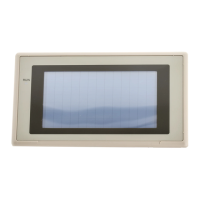3-8SectionUsing the Alarm List/History Function
347
• For alarm history: Check mark set
• String Table Entry:
Table entry number (0 to 1999) of the character string memory table entry to be
displayed as a message
• Image/Library Code:
Image/library code displayed together with a message
• 0000
H: No display
• 0001
H to 0FFFH: Image
• 1000
H to 3FFFH: Library display
• Screen No.
Screen No. (0001 to 3999) of the screen to be displayed when the message
is pressed twice.
This setting is valid only when switching the screen.
Alarm List/History
Register an alarm list/history to a screen in the manner described below (for in-
formation not indicated below, set as needed.).
• Alarm list
• Start bit table entry:
Table entry number of the first bit memory table entry among the bit
memory table entries where the bits in the host to be monitored are regis-
tered.
• No. of bits referenced:
The number of the bit memory table entries where the bits in the host to be
monitored are registered.
• Alarm history
• Type: Order of frequency or order of occurrence
To display the alarm history in the order of occurrence, set the display order
(From Old Data/From New Data) of the record data using the Hist. Disp.
Method memory switch of the PT.
Reference: The image and library codes are different when NT20S or NT30/620 compatible
mode is being used.
Operation
1, 2, 3... 1. Initialize the recorded alarm history record data as needed.
To initialize the alarm history record data using System Menu operation, se-
lect Alarm History on the MEMORY INIT. MENU screen.
To initialize the alarm history record data by operation at the PT status con-
trol area, change the status of bit 1 in the 4th word (word n + 3) from the be-
ginning of the PT status control area to 1 (ON).
After initializing the alarm history record data by operation at the PT status
control area, return the status of bit 1 to 0 (OFF).
2. Display the screen where the alarm list/history is registered.
In the case of an alarm history, the recorded data is displayed on the screen.
In the case of an alarm list, the content of the set character string memory
table entry is displayed as a message if the status of the bit in the host to be
monitored changes to 1 (ON).

